How Nudge Theory in Business Drives Employee Engagement and Smart Decision-Making
Learn how nudge theory in business helps organizations shape better employee behavior through subtle cues, boosting engagement, motivation, and outcomes
On this page
We make a lot of decisions every day. Some simple, some difficult, and some we don’t even notice. How can we make our employees make the right decisions so that they grow personally and contribute effectively to the organization? Read about nudge theory in practice - while it is used to influence employee behavior.
“On an average, a human brain makes 35,000 decisions each day,” says Barbara Sahakian, a clinical neuropsychology professor at Cambridge University and the author of the book Bad Moves. How decision-making goes wrong, and the ethics of smart drugs. Just choosing what we eat constitutes at least 200 decisions. Fascinating, isn’t it?
Now imagine if we were consciously making all these decisions. Ugh!
To make our lives easier, our brains take simple shortcuts to make most decisions without involving our conscious minds – called heuristic decision making. 90% of the decisions made each day are unconscious, says Susan Weinschenk, a behavioral psychologist.
In an online class that she conducts Brain and Behavioural Science, she goes on to say
“We often like to think that we’re very rational and logical. But we’re not. And, if you want to really reach people, if you want to communicate with them, if you want to persuade them, you need to figure out how to talk to the unconscious part of their mind.”
Human beings are highly emotional, and the decision-making process is greatly affected by emotions. So much so that some behavioral economists have suggested that only up to 30% of the decisions we make are rational and 70% emotional.

Emotions constitute powerful, pervasive, and predictable drivers of decision-making. One characteristic of emotion is that it compels us to do something - pushes us towards taking action.
And with time, most organizations have effectively used this understanding to subtly influence employee behavior by nudging them to make better decisions.
What is a nudge?
To put it into simple words, a nudge is nothing but a simple, subtle cue that naturally leads people to make choices that YOU want them to make. It's not about penalizing them in any way or limiting their freedom if they have not acted in a certain way, but to help their decision-making process be more manageable.
Behavioral economists Richard H. Thaler and Cass R. Sunstein, in their book Nudge: Improving Decisions about Health, Wealth, and Happiness, define nudge as "any aspect of the choice architecture that alters people's behavior in a predictable way without forbidding any options or significantly changing their economic incentives".
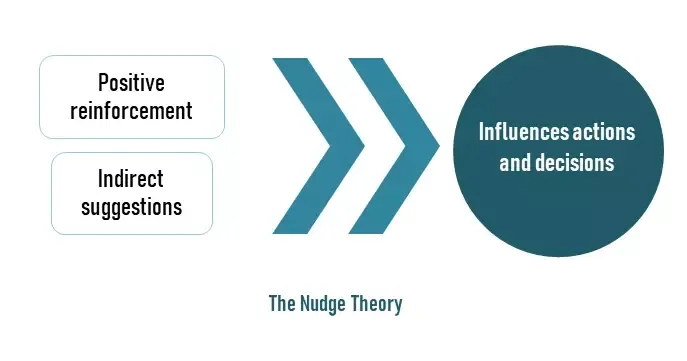
Nudge theory suggests that positive reinforcement and indirect suggestions can influence people’s actions and decisions – most of the time, without them even realizing it.
Where did nudge theory originate?
It all started with a urinal fly—yes, you read that right!
In the 1990s, a cleaning manager at Schiphol Airport in Amsterdam faced a common problem: excessive cleaning costs due to spillage in men’s restrooms. To tackle this, he came up with a surprisingly simple idea—place an image of a fly in the urinal for men to aim at. Flies were chosen because they weren’t intimidating, and no one seemed to mind aiming at them.
The results were astonishing. This small change led to an 80% reduction in spillage and an 8% decrease in cleaning expenses. The concept quickly gained global recognition and became a classic example of how a small behavioral cue can drive significant results.
This clever use of behavioral psychology eventually contributed to the development of nudge theory. It inspired University of Chicago’s Richard Thaler and Cass Sunstein, who later popularized the theory and won a Nobel Prize in Economics for their work.
How does nudge theory work?
Nudge theory works by subtly guiding people toward desired behaviors and decisions without restricting their freedom of choice. Instead of enforcing rules or imposing penalties, it leverages psychological cues and environmental design to influence decision-making. The goal is to make the preferred choice easier, more accessible, or more appealing, encouraging individuals to act in ways that benefit both themselves and the organization.
At its core, nudge theory is rooted in behavioral economics and cognitive science. It recognizes that people don’t always make rational decisions and are often influenced by how information is presented. For example, placing healthier food at eye level in a cafeteria nudges employees to choose better meals without banning other options. These small, strategic changes—known as "nudges"—can significantly impact behavior when implemented thoughtfully.
In the context of the workplace, nudges can be applied to improve productivity, enhance employee engagement, or promote healthier habits. A workplace nudge might include sending timely reminders about deadlines, using positive reinforcement in performance reviews, or structuring choices in employee benefit programs to favor options with long-term advantages.
The effectiveness of nudge theory in business lies in its subtlety and cost-efficiency. It avoids forceful interventions, instead fostering a culture of autonomy and trust. Whether it’s increasing participation in wellness initiatives or encouraging employees to complete training modules, nudge theory implementation offers a smart, human-centered way to influence workplace behavior.
Let’s look at an example of how nudging is applied in the real world:
A lot of websites that offer a tiered pricing model often highlight a particular pricing model to be the “most popular” of all. By telling the website users that the particular pricing model has been adopted by most users in the past, they are only trying to influence the new users to go with that pricing model as well.
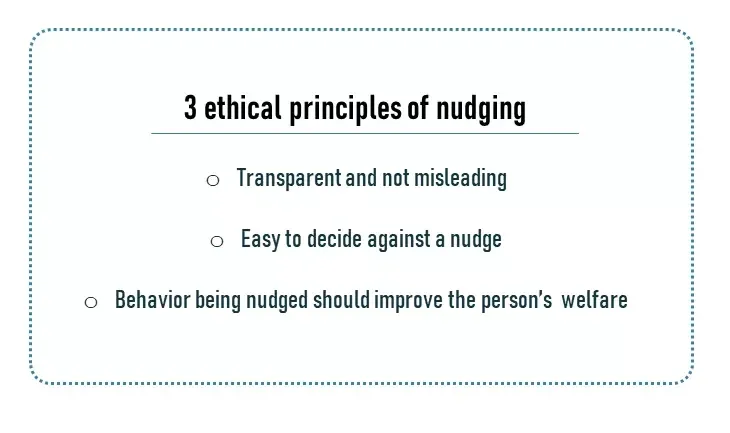
Richard Thaler emphasizes three ethical principles when it comes to nudging:
- Nudges must be transparent and not misleading.
- It should be as easy as possible to decide against a nudge.
- Nudges should be framed in such a way that the behavior being encouraged will improve the welfare of those being nudged.
Though formal theories and studies have only emerged recently, people have probably been exhibiting nudging behavior for as long as history can take us (The story of the Potato King is a great example here).
The great thing about good nudges is that they can be applied to any aspect of our daily lives - be it in educational institutions, government policies, political agendas, or whatnot. And the field of business is no exception.
Influencing employee behavior through nudges
A greater number of companies are connecting the dots these days between happier employees and improved productivity and in turn, happier customers.
While there are a number of ways to influence employee behaviors, we try to explore some of the methods to effectively nudge employees towards better organizational results.
1. Nudging to build better managers
"To do great things is difficult, but to command great things is more difficult." - Friedrich Nietzsche
We have all come across the phrase “He was the best manager I have ever had”. But do we really know what it takes to become a great manager? Being a good manager is definitely more than just driving your employees towards better performance and better results.
Great managers are the ones who often succeed in guiding, shaping, and steering their teams to greater heights of engagement, job satisfaction, and efficiency.
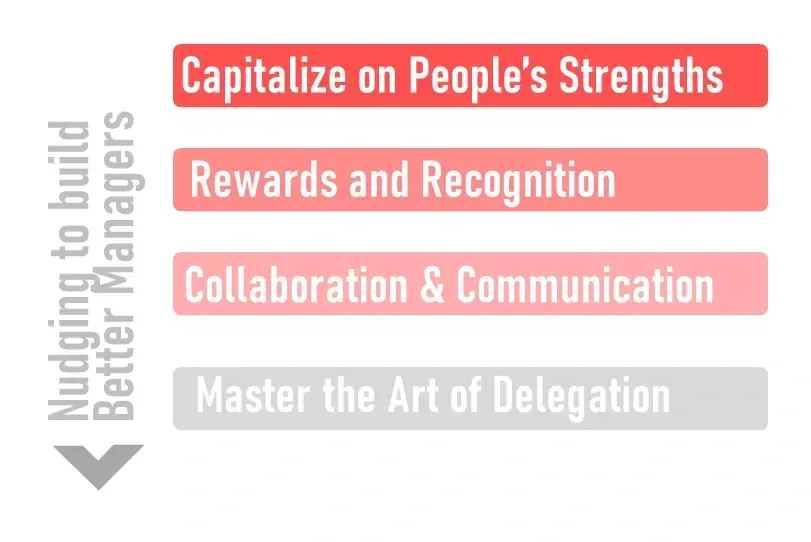
Here are some simple tricks that will nudge managers to become better versions of themselves:
- Capitalize on people’s strengths
You always find people with varied strengths, attitudes, capabilities within your team. Learn to understand each employee’s strengths and capitalize on them to achieve the best results for the team as well as the organization.
Remember, it also takes different strategies to engage and motivate each one of them based on their strengths and interests.
- Make rewards and recognition your best friend
When employees feel valued and appreciated for their efforts, they tend to perform better and stay engaged. Especially when employees are recognized amongst their peers, it not only values the achiever but also shows to everyone in the team that hard work gets recognized.
However, it is important to precisely define triggers for these rewards and be consistent so that it doesn’t come across as playing favorites.
That’s where Empuls makes a real difference. It enables organizations to build a fair and consistent rewards and recognition program that’s transparent, inclusive, and easy to manage. With built-in AI nudges, peer-to-peer recognition, and customizable award triggers, Empuls ensures that every contribution is acknowledged in real time—eliminating bias and promoting a culture of appreciation that resonates across teams.
- Master the art of delegation
One of the keys to becoming a great manager is to effectively delegate work and encourage your teammates to take complete ownership of the delegated work. While assigning tasks and responsibilities, always keep their strengths and interests in mind to drive the best performances.
Being a successful manager can be challenging at times. In order to succeed in this position, it is crucial for you to remember that your success is directly dependent on your team. So, as a manager, building a team that is engaged, motivated, and driven is the key to your success as well.
- Nurture collaboration & communication
Involve your team in discussing important issues, take their views before making decisions (especially the ones that affect them), seek their opinion on the problems you are facing – encourage these behaviors to effectively motivate your team. Make sure you are communicating everything with almost clarity and accuracy.
Empuls helps you keep communication transparent and inclusive with features like pulse surveys, feedback tools, and a social intranet—so every voice is heard and valued.
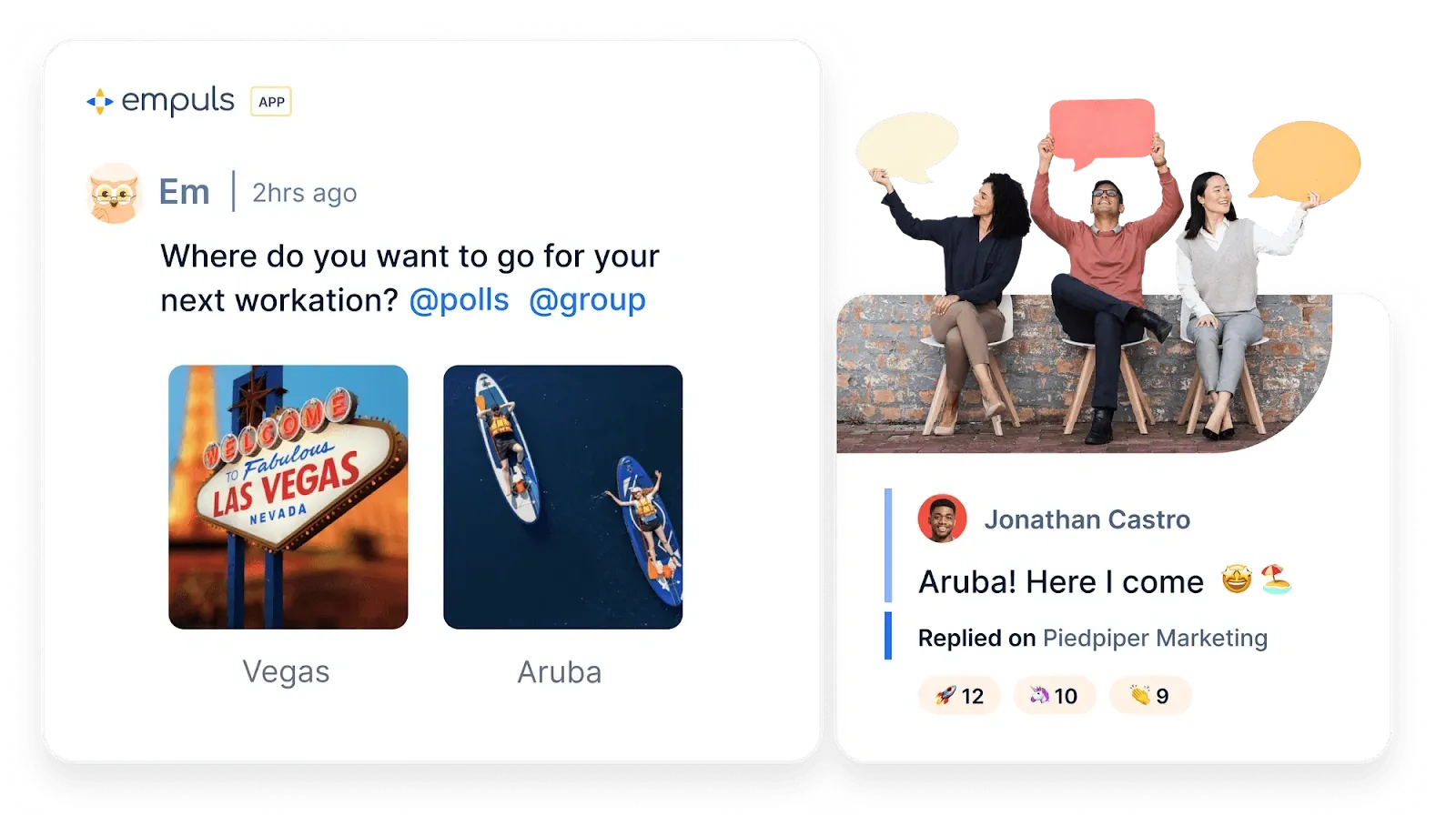
2. Nudging employees to create a culture of appreciation
“Gratitude can transform common days into thanksgiving, turn routine jobs into joy, and change ordinary opportunities into blessings.” – Proverb
We all feel elated when we are genuinely thanked by someone or appreciated for the work we have done, don’t we? That is because human beings have an innate desire to be appreciated and valued for what work they do.
Employees who feel valued and appreciated often are the ones who have deep job satisfaction, the ones who will be willing to work longer hours, the ones engaging in productive relationships with their peers and managers, the ones that are motivated to do their best, and work towards achieving organizational goals.
Apart from routinely thanking employees for their efforts, there are a number of ways to nudge employees towards a culture of gratitude.
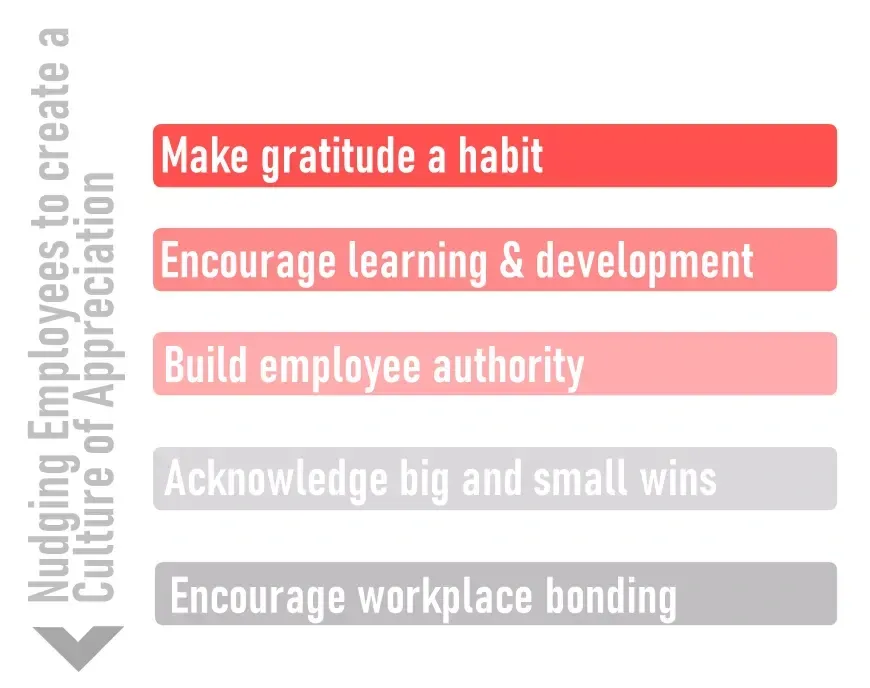
Here, we try to explore some of the methods that have been proven to be effective:
- Make gratitude a habit
We can all get extremely absorbed in our day-to-day lives – balancing professional and personal lives. It is important to encourage employees to take moments of time out, every once in a while, to thank someone’s effort.
Eg: While beginning a meeting, you can always start off by appreciating the efforts of one of your team-mates, Or, have a “Gratitude Board” in your office (or on the intranet), where anyone can go and pin a thank-you message to anyone else in the organization. Small steps like these can go a long way in building employee morale and motivation.
- Encourage learning & development
Employees feel they are valued when the organization takes an interest in their learning and development. They appreciate organizational initiatives like workshops, training, exposure to new projects, etc. that help them develop important work skills, beyond what they were hired for. Even when promotion opportunities are limited, employees are said to experience a higher level of satisfaction and engagement in expanding their skills.
- Build employee authority
Employees feel extremely valued when their opinions are heard and are encouraged to take part in the decision-making process. A sense of authority is experienced while being involved in discussions and tasks that have an impact on organizations growth, in turn leading to higher levels of job satisfaction
- Acknowledge wins–Both big & small
Appreciate achievements however big or small. This invokes a desire in employees to keep performing better and consistently achieve better results. For all we know, each win matters to the employee as well as the organization.
- Encourage workplace celebrations & friendships
The classic example of this will be birthday celebrations, retirement celebrations, deal-win celebrations, product launches, etc. Such celebrations encourage appreciation that is more inclusive and less competitive while encouraging employees to socialize with one another. This can go a long way in building stronger engagement with the organization.
Building a culture of gratitude within the workplace definitely takes time and effort but comes with its own rewards of increased employee performance and satisfaction.
Organizations with an open culture that promotes employee input, routinely reward and recognize performance, and encourages personal growth is definitely headed towards building a culture of gratitude amongst employees.
Creating a culture of gratitude goes beyond occasional celebrations. It involves recognizing everyday wins, supporting well-being, and fostering genuine connections.
Empuls makes this easy by enabling peer recognition, automating celebrations, and offering wellness benefits—all in one platform. With features like a social intranet and a global rewards catalog, Empuls helps organizations embed appreciation into daily work life and strengthen employee engagement.
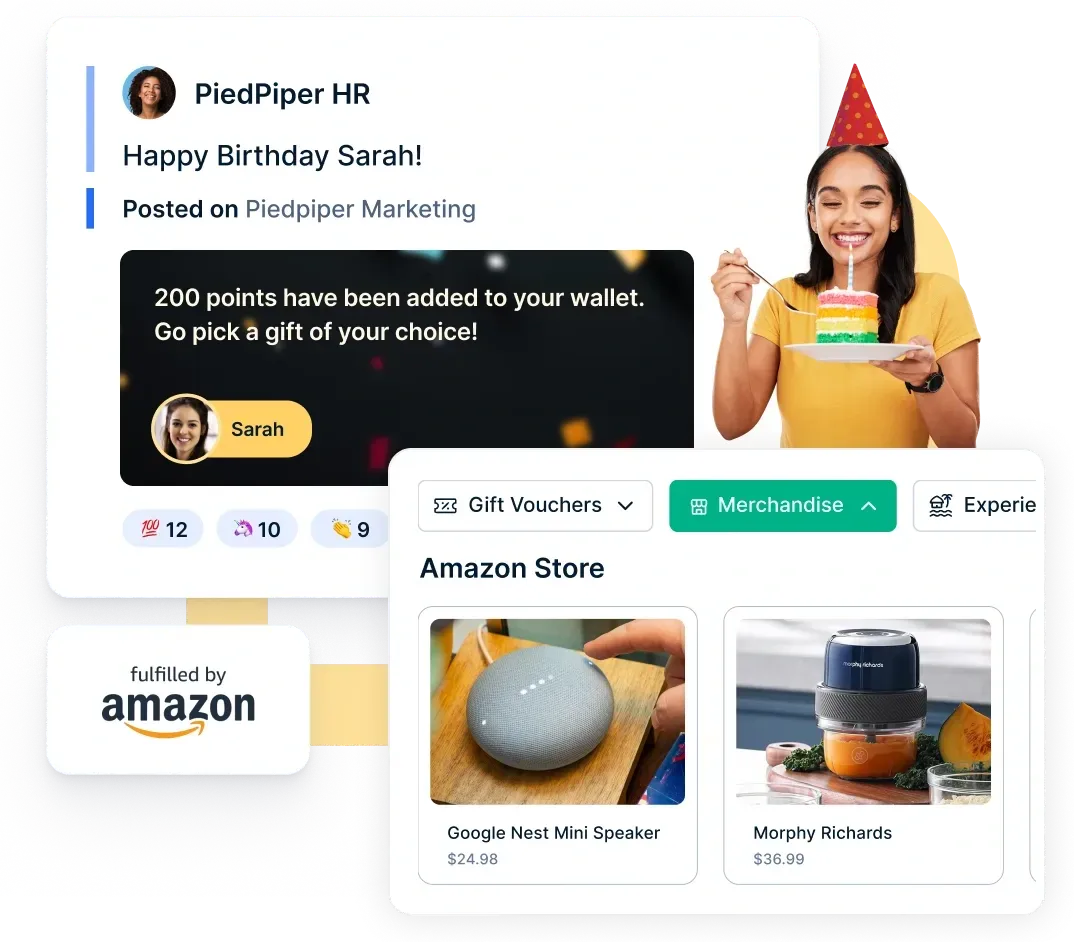
3. Nudging the leadership to enhance employee engagement
“The greatest leader is not necessarily the one who does the greatest things. He is the one that gets the people to do the greatest things.” – Ronald Reagan
Organizations often spend a huge sum of money on training leaders and developing leaders, often to see them fail in a short period of time. Leadership roles can be extremely challenging with constantly changing business environments and complex decision-making processes.
Sometimes, what cannot be achieved by development programs can be achieved by simple nudges. Instead of defining leadership competencies and behaviors, when nudges are used to influence their decisions, leaders are more likely to succeed.

Here are some important nudge strategies for leaders to adopt to build an engaged workforce:
- Set clear goals and reward employees for achieving goals
Ensuring that your employees are crystal clear about their goals and how it aligns with the organizational goals is perhaps the most effective way to engage and motivate them.
When employees understand what is expected out of them -monthly, quarterly, and annually–it helps them focus on the performance and deliver better results on time. Rewarding employees who successfully achieve their goals further adds to the motivation.
- Learn to recognize potential
Leaders may exist at any level within the organization. Whenever you come across employees who have performed exceptionally well under difficult or unusual circumstances, never forget to appreciate and recognize their potential.
These might be the people who have hidden skills and behaviors that make them capable of fitting into critical roles in the future.
- Support your managers through coaching
Encourage a culture of open discussions where your employees feel free to come to you to discuss their challenges and fears. Coach them on various tricks of the trade that will help them perform better in their respective roles.
These are only illustrative examples of some of the nudges that leaders can apply to improve engagement within the organization. There can be a number of other nudges that can be structured to push employees towards better health, reduced absenteeism, increased productivity, and engagement.
Examples of nudging in the workplace
Nudging is a subtle yet powerful way to influence behavior without restricting options or changing incentives. In the context of the workplace, nudges are used to encourage positive actions and better decision-making. Below are examples of how nudging can be effectively implemented across different roles and scenarios, aligned with nudge theory in business.
1. Email reminders and prompts
Sending email nudges to employees about upcoming deadlines, pending tasks, or wellness initiatives is a classic workplace nudge. These gentle reminders promote productivity and accountability without pressure.
2. Default options in employee benefits
Automatically enrolling employees in retirement savings plans, health screenings, or wellness programs taps into nudge theory implementation. While employees can opt-out anytime, setting the default encourages beneficial participation.
3. Visual cues in shared spaces
Strategically placing signs or visual prompts—like posters encouraging clean desks or recycling bins near printers—serve as workplace nudges. These influence behavior without overt enforcement.
4. Calendar nudges for focus time
Blocking specific hours in employee calendars as “no meeting zones” encourages deep work. This nudge reduces distractions and increases focus, demonstrating how small shifts can enhance productivity.
5. Recognition nudges
Nudging managers to recognize team members regularly (e.g., through automated reminders or platform suggestions) helps build a culture of appreciation. This is an example of nudge theory implementation in employee engagement strategies.
Feature | Nudging Functionality |
Em AI Bot | Personalized smart nudges |
Automated Recognition | Reminders for birthdays, milestones |
Rewards Automation | Suggests budget-friendly yet impactful rewards |
Survey Reminders | Encourage feedback and participation |
Social Feed & Intranet | Encourages visibility and celebration |
Fringe Benefits & Salary Advance | Nudge financial wellness without stress |
How Empuls embeds nudging in the platform
Nudge theory is built on the principle of influencing behavior without force—making the desired action easier, more attractive, or the default. Empuls leverages this principle across its platform by embedding subtle behavioral cues into the digital workplace environment to guide employees toward positive actions.
1. Recognition & rewards nudges
Powered by the AI bot "Em", Empuls uses smart nudges to:
- Remind managers to recognize employees for recent achievements.
- Suggest peers who haven’t been appreciated recently to promote inclusivity.
- Nudge employees to log weekly accomplishments that can later be recognized.
A weekly nudge to managers: “Hey! Sam completed a major milestone this week—how about a shoutout?”
Birthday and service anniversary nudges to ensure no moment of appreciation is missed.
2. Goal-oriented leadership nudges
Empuls helps leaders by:
- Providing intelligent insights into employee sentiment via eNPS, pulse, and lifecycle surveys.
- Nudging leaders with AI-driven recommendations to address disengagement hotspots or morale dips.
3. Building a culture of gratitude
Through features like:
- Social Intranet for open celebrations and recognition
- Wishboards for birthdays, work anniversaries, or life events
- Peer-to-peer recognition with automated reminders
These serve as gentle prompts encouraging team bonding, collaboration, and appreciation.
4. Nudge-based learning & wellness
Empuls integrates nudges into learning and wellness reward cycles, reminding employees to:
- Participate in fitness contests or mindfulness programs
- Upskill through learning modules
- Join mental wellness initiatives
5. Frictionless perks adoption
The Perks & Discounts module nudges employees to make better financial choices:
- Defaults set to cost-saving options
- Notifications on limited time deals or cashback offers
- Smart suggestions based on past redemption patterns.
Schedule a call with Empuls now!
Closing thoughts
We see nudges everywhere, and you’re most likely already using them in your organization’s strategies. However, looking further into how nudging techniques can be customized to each cadre and personalized to influence the actions of each employee is what drives the best outcome.


















